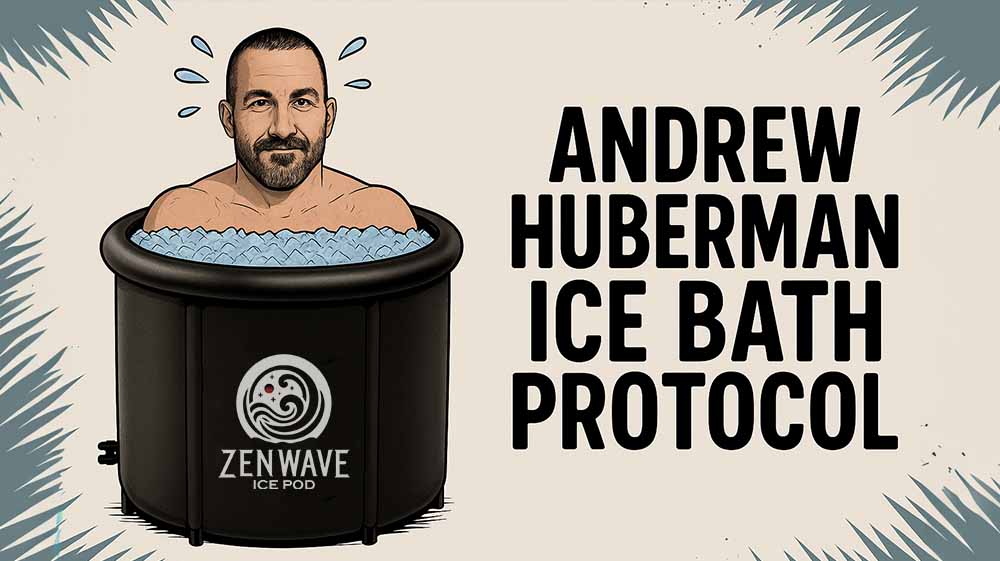Most people overcomplicate cold exposure. Dr. Andrew Huberman doesn’t.
His protocol is simple: 11 minutes of cold immersion per week. Not per day. Not in one sitting. Just 2–4 short sessions, spread across the week. That’s it.
If you’re brand new to cold exposure, start by learning what an ice bath actually is.
And it works — because it’s based on how your nervous system actually responds to cold stress. We’ve tested it ourselves. It’s efficient, sustainable, and far more effective than most people expect.
His protocol is simple: 11 minutes of cold immersion per week. Not per day. Not in one sitting. Just 2–4 short sessions, spread across the week. That’s it.
And it works — because it’s based on how your nervous system actually responds to cold stress. We’ve tested it ourselves. It’s efficient, sustainable, and far more effective than most people expect.
Why 11 Minutes? What the Research Shows
Here’s what Huberman found — and why it matters:
Cold exposure creates a lasting neurochemical shift. Specifically:
- Dopamine increases — so your mood, drive, and focus stay elevated for hours.
- Epinephrine and norepinephrine spike — sharpening attention and boosting energy.
- Top-down control kicks in — your brain learns to stay calm under pressure.
In short? You don’t just feel better. You become more resilient.
There’s a metabolic advantage too: cold immersion activates brown fat activation in ice baths, which burns calories to keep you warm — and improves thermoregulation over time.
How Cold Should the Water Be?
Here’s Huberman’s simple rule: “uncomfortably cold, but safe to stay in.”
For a deeper breakdown of temperature targets, check out our guide to ideal ice bath temps.
For most people:
- Beginners do well around 50–59°F
- Advanced users drop as low as 45°F
If you’re new, don’t chase extremes. You should want to get out — but still feel confident you can stay in. That’s the zone where growth happens.
The Protocol: How to Actually Do It
Here’s the weekly structure:
- 2–4 sessions/week
- 1–5 minutes per session
- Total goal: 11 minutes/week
- Neck-deep cold water (if possible)
- Ice baths preferred — cold showers can work if that’s all you’ve got
After each session, skip the hot shower. Let your body rewarm naturally. That’s where the real adaptation kicks in. rewarming after an ice bath.
The “Counting Walls” Technique
We’ve all had that moment: the water hits, and your brain screams, “GET OUT.”
Huberman calls these “walls.” Each wall is a physiological signal — a surge of adrenaline that hits your system as you begin to panic. It’s a totally natural response. But instead of reacting impulsively, the idea is to lean in and observe it.
That’s the moment you build what Huberman calls top-down control — training your prefrontal cortex to override your fear response. And the more walls you pass through, the more resilient your nervous system becomes.
You’ve got two options:
- Use a timer and stay in for a set duration
- Or count walls — push through 3, 4, or even 5 clear “I want out” moments
Each wall is its own rep. The first might hit as your body seizes up. The second when you feel your breathing go shallow. The third when you mentally check out. Instead of quitting, you hold the line. You breathe.
Why it works: it’s not about staying cold — it’s about building reps under stress. And those reps translate far beyond the plunge. Into workouts. Into meetings. Into life.
Tip: If you’re new, aim for two walls. That alone builds serious carryover. Then work your way up to five.
The Søeberg Principle: End Cold. Shiver On Purpose.
This one’s powerful — and underused.
Dr. Susanna Søeberg’s research shows that shivering after cold exposure activates more brown fat and enhances metabolic adaptation.
So, instead of toweling off:
- Let yourself air dry
- Don’t huddle
- Let your body rewarm on its own
Yes, it’s uncomfortable. That’s the point. Growth lives there.
Want help prepping your setup? Use our ice bath gear checklist.
When Should You Do It?
Huberman’s advice is clear:
Do cold exposure in the morning or after training — when you want more alertness and drive.
Avoid it before bed — because it raises your core temperature, which can disrupt sleep.
And don’t cold plunge right after strength training if you’re chasing gains. Wait a few hours. Recovery and adaptation don’t always overlap.
Huberman Protocol in Real Life
Wondering how often to use this protocol? We cover that here: how often to plunge.
Here’s a simple starter plan:
| Day | Duration | Temp | Focus Point |
|---|---|---|---|
| Mon | 3 min | 55°F | Count 3 walls |
| Wed | 4 min | 50°F | Move arms/legs in water |
| Fri | 4 min | 52°F | Let yourself shiver afterward |
Mix and match to fit your week. Just hit 11 total minutes.
Final Take: 11 Minutes. That’s All It Takes.
This isn’t about how tough you are. It’s about showing up with consistency and intention.
11 minutes a week of deliberate cold will:
- Train your nervous system
- Improve your mood and energy
- Build real, transferable resilience
Want a cold plunge setup that actually makes this easy to do? The ZenWave Ice Pod is our go-to. Durable, simple, and made for this exact protocol.
Cold isn’t punishment. It’s a training tool. Use it right — and get stronger on purpose.

